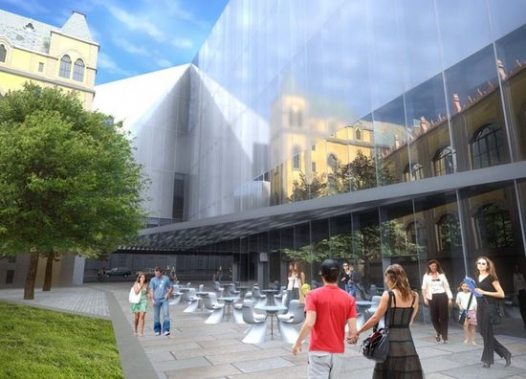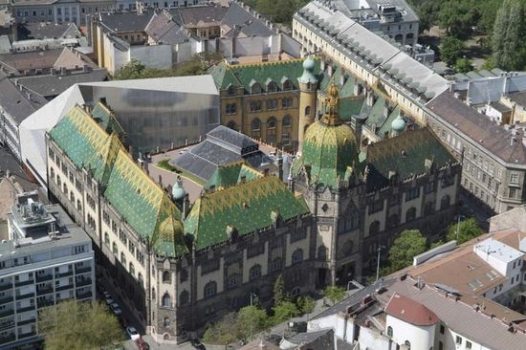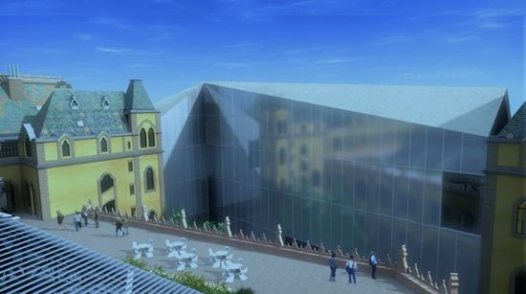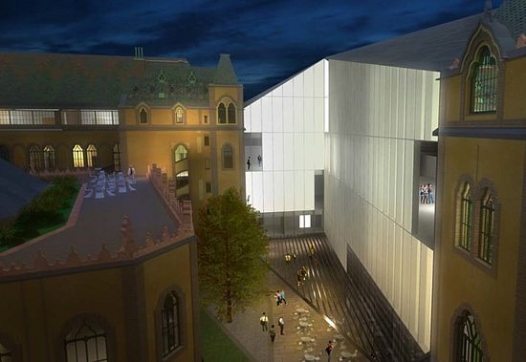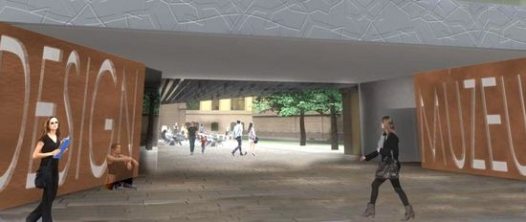The current building in Üllői Street was completed in 1896 and it is one of the most original and richly decorated examples of a characteristic Hungarian design language. The architect Ödön Lechner?s plan was never fully implemented and even today, part of the building which occupies the sides of the plot is missing. Next to the impressive glass hall, between the three wings and the central mass, valuable space is taken up by disorganised areas, used mostly for depositing waste. A comprehensive revamp has never been carried out and in recent years, the building?s condition has tragically declined. A 30-tonne lantern tower covered with Zsolnay tiles decorating the dome was declared hazardous and removed last year, and disintegrating pieces have been falling from the roof from time to time.
But the task specified in the architectural competition was even broader. While preserving and restoring the original architectural masterpiece, a state-of-the-art museum structure had to be created which would also house the Hungarian Design Museum, with links to the old collection. The plans therefore had to comply with exceptionally strict criteria, making use of the emblematic historical building, and at the same time meet a very complex urban design challenge.
The submitted works were assessed on the basis of complexity, quality of design and usability, as shown in the detailed description of submitted plans in the museum?s website. The professional jury seems to have used a very consistent approach and did not give in to the inescapable aesthetic bluffs or to designs that focused excessively on far-flung and contemporary features. They were after the highest architectural quality and not after impressive visuals. Of the 35 works submitted for the competition, they looked for one that most sensitively projects on the direct urban environment, communicating both inside and outside but not trying to overshadow Lechner?s design. ?Respectful reinterpretation? has been the guiding line in the assessments.
At the same time, the linking of the museum to be with Lechner?s building emphasises the difference that is increasingly evident between the interpretation of museums at the end of the 19th century and today. It is not sufficient anymore to educate by collecting and conserving, preserving and presenting. The mutual and versatile communication between museums and audiences makes classical museum events obsolete and brings in the notions of education and training outside the classroom and life-long education. What?s more, this museum now demands greater openness in space and function in a field which is relatively new in a museum context, at least in Hungary: design. The objects presented here are much closer to our everyday lives than other art object usually seen in museums.
The already completed tender and a construction project that is expected to take 4-5 years mean that the Museum of Applied Arts has thoroughly reinvented itself after a long century. Besides getting an overhaul that will involve the expansion of total floor space by 25 percent, the construction of new exhibition areas in the basement, a restaurant, a conference centre, a roof terrace above the lobby and open courtyards, its expanded functions will mean that the museum can finance itself. The Lechner-designed building will be utilised in a most up-to-date way, combining storage areas with museum displays which will make it possible to present a much larger collection than today, offering a more thorough overview of its extremely rich collection, even in European standards. The new wing which will be dedicated to design will also function as a separate museum. Its architectural character will draw a fine timeline between the old and the new. To the outside, it will show a concrete surface but on the interior side, reflecting surfaces, a crystal-shaped roof and a glass façade towards the courtyard will express a welcoming attitude. The same optical trick will introduce a vibrant contemporary lifestyle in the currently rundown courtyard.
The design by András Vikár and István Lukács is characterised by a playful architectural vision rather than a grand-scale approach which was seen in many other bids. It involves a concept of usability which is followed consistently throughout the design, with precise and attentive responses to the problems that arose, never eclipsed by the desire to create an architectural landmark for the future. It is a rare virtue to have such moderated attitude and flexibility towards non-architectural considerations. This plan appropriately adjusts to the aura of the architectural icon designed by Lechner.
Author: Eszter Götz
